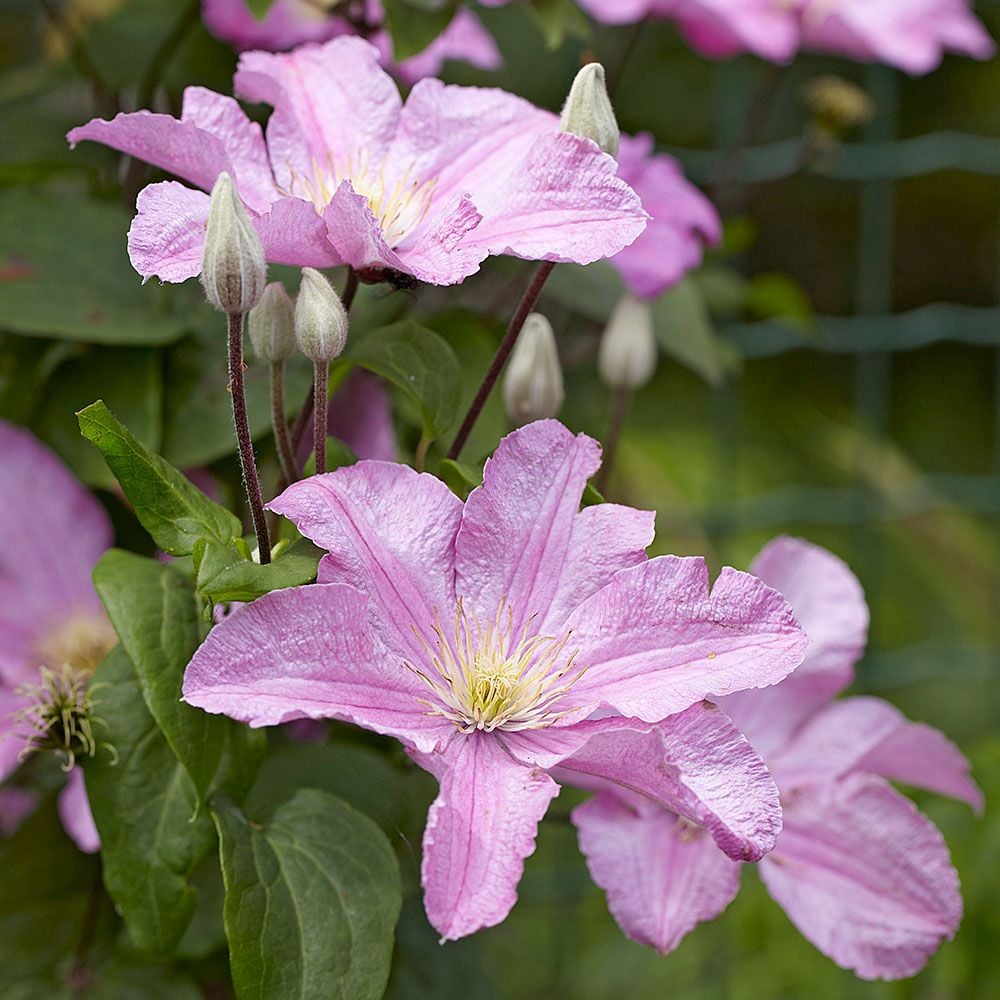Absolutely! Here’s a comprehensive article about Clematis ‘Comtesse de Bouchaud’, incorporating your requested formatting changes and expanding upon the provided information.
Clematis ‘Comtesse de Bouchaud’ is a beloved and enduring cultivar, celebrated for its prolific flowering, robust growth, and adaptability. This vigorous climber, with its satin-textured, mauve-pink blooms, has graced gardens for over a century, earning its place as a true classic.
Origins and History
The story of ‘Comtesse de Bouchaud’ begins in France, where it was bred by Francisque Morel in 1885. Its name honors a prominent French noblewoman, reflecting the elegance and charm of the plant itself. This cultivar quickly gained popularity, spreading throughout Europe and beyond, admired for its reliable performance and captivating beauty.
Characteristics and Appearance

‘Comtesse de Bouchaud’ is a late large-flowered clematis, blooming profusely from midsummer to early autumn. Its flowers, typically 4-6 inches in diameter, are characterized by their soft, rosy-mauve hue, which can vary slightly depending on soil and climate. The petals, usually six to eight in number, have a slightly ruffled or wavy edge, adding a touch of delicate texture. The creamy-yellow anthers at the center of each flower provide a subtle contrast, enhancing the overall visual appeal.
Growth Habit and Size
This clematis is a vigorous climber, capable of reaching heights of 8-12 feet (2.4-3.7 meters). It climbs by twining its leaf petioles around supports, making it ideal for trellises, arbors, fences, and walls. Its deciduous leaves are typically mid-green, providing a lush backdrop for the abundant blooms.
Flowering and Scent
‘Comtesse de Bouchaud’ is renowned for its extended flowering period, producing a profusion of blossoms from July to September. While the flowers are not strongly scented, they emit a subtle, sweet fragrance that can be enjoyed up close.
Cultivation and Care
Successful cultivation of ‘Comtesse de Bouchaud’ relies on providing the right conditions and care.
Planting and Location

Sunlight: This clematis thrives in full sun or partial shade. It prefers at least six hours of sunlight per day for optimal flowering.
Watering and Feeding
Watering: Water deeply and regularly, especially during dry periods. Clematis prefers consistently moist but not waterlogged soil.
Pruning
‘Comtesse de Bouchaud’ falls into pruning group 3, which means it flowers on the current season’s growth.
Annual Pruning: Prune hard in late winter or early spring, cutting back all stems to about 12-18 inches (30-45 cm) above ground level. This encourages vigorous new growth and abundant flowering.
Pest and Disease Management

While generally robust, ‘Comtesse de Bouchaud’ can be susceptible to certain pests and diseases.
Clematis Wilt: This fungal disease can cause sudden wilting and death of stems. Prevent it by planting deeply, ensuring good drainage, and avoiding overwatering. Remove and destroy any affected stems immediately.
Landscape Uses and Companion Plants
‘Comtesse de Bouchaud’ is a versatile climber that can be used in a variety of landscape settings.
Vertical Interest
Train it on a trellis or arbor to create a stunning vertical display.
Companion Plants
Combine it with roses for a classic cottage garden look.
Container Gardening
‘Comtesse de Bouchaud’ can also be grown in large containers, provided they have adequate drainage and support. Use a high-quality potting mix and water regularly.
Variations and Similar Cultivars
While ‘Comtesse de Bouchaud’ is a standout cultivar, there are other clematis varieties with similar characteristics.
Similar Cultivars
’Jackmanii’: Another classic late-flowering clematis with deep purple blooms.
Benefits of Growing Clematis ‘Comtesse de Bouchaud’
Prolific flowering: Provides a long and abundant display of blooms.
Conclusion
Clematis ‘Comtesse de Bouchaud’ remains a garden favorite for its reliable performance, beautiful blooms, and ease of care. This versatile climber adds a touch of elegance and charm to any landscape, making it a worthy addition to gardens of all styles. Whether trained on a trellis, climbing through a shrub, or cascading from a container, ‘Comtesse de Bouchaud’ is sure to captivate and delight with its abundant, rosy-mauve flowers. Its enduring popularity is a testament to its exceptional qualities, making it a timeless treasure in the world of clematis.

